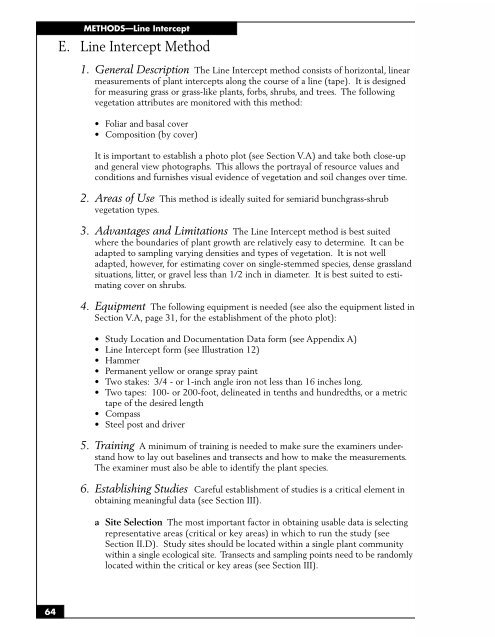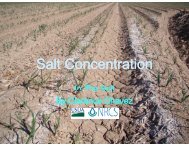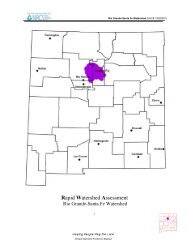SAMPLING VEGETATION ATTRIBUTES - New Mexico NRCS - US ...
SAMPLING VEGETATION ATTRIBUTES - New Mexico NRCS - US ...
SAMPLING VEGETATION ATTRIBUTES - New Mexico NRCS - US ...
Create successful ePaper yourself
Turn your PDF publications into a flip-book with our unique Google optimized e-Paper software.
64<br />
METHODS—Line Intercept<br />
E. Line Intercept Method<br />
1. General Description The Line Intercept method consists of horizontal, linear<br />
measurements of plant intercepts along the course of a line (tape). It is designed<br />
for measuring grass or grass-like plants, forbs, shrubs, and trees. The following<br />
vegetation attributes are monitored with this method:<br />
• Foliar and basal cover<br />
• Composition (by cover)<br />
It is important to establish a photo plot (see Section V.A) and take both close-up<br />
and general view photographs. This allows the portrayal of resource values and<br />
conditions and furnishes visual evidence of vegetation and soil changes over time.<br />
2. Areas of Use This method is ideally suited for semiarid bunchgrass-shrub<br />
vegetation types.<br />
3. Advantages and Limitations The Line Intercept method is best suited<br />
where the boundaries of plant growth are relatively easy to determine. It can be<br />
adapted to sampling varying densities and types of vegetation. It is not well<br />
adapted, however, for estimating cover on single-stemmed species, dense grassland<br />
situations, litter, or gravel less than 1/2 inch in diameter. It is best suited to estimating<br />
cover on shrubs.<br />
4. Equipment The following equipment is needed (see also the equipment listed in<br />
Section V.A, page 31, for the establishment of the photo plot):<br />
• Study Location and Documentation Data form (see Appendix A)<br />
• Line Intercept form (see Illustration 12)<br />
• Hammer<br />
• Permanent yellow or orange spray paint<br />
• Two stakes: 3/4 - or 1-inch angle iron not less than 16 inches long.<br />
• Two tapes: 100- or 200-foot, delineated in tenths and hundredths, or a metric<br />
tape of the desired length<br />
• Compass<br />
• Steel post and driver<br />
5. Training A minimum of training is needed to make sure the examiners understand<br />
how to lay out baselines and transects and how to make the measurements.<br />
The examiner must also be able to identify the plant species.<br />
6. Establishing Studies Careful establishment of studies is a critical element in<br />
obtaining meaningful data (see Section III).<br />
a Site Selection The most important factor in obtaining usable data is selecting<br />
representative areas (critical or key areas) in which to run the study (see<br />
Section II.D). Study sites should be located within a single plant community<br />
within a single ecological site. Transects and sampling points need to be randomly<br />
located within the critical or key areas (see Section III).




